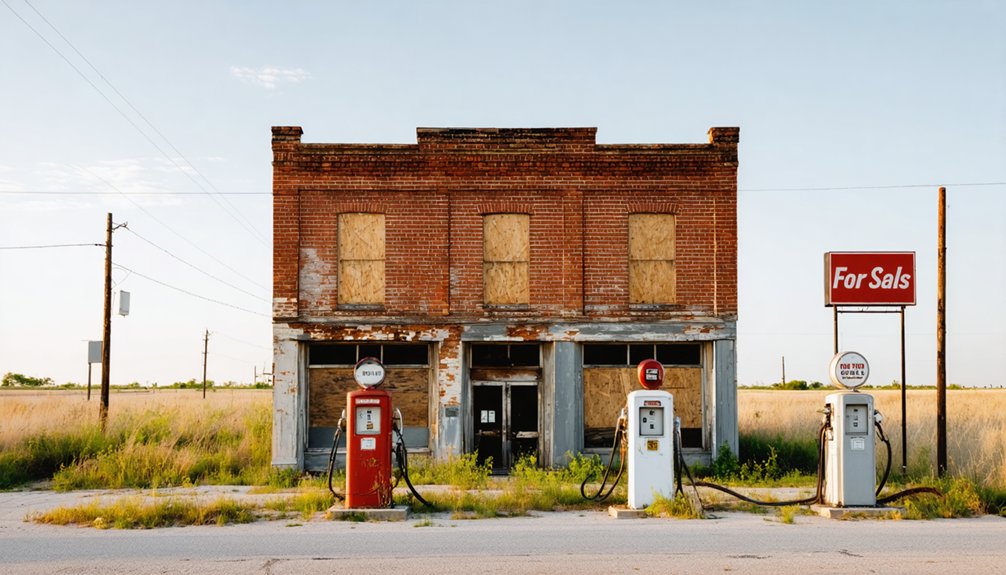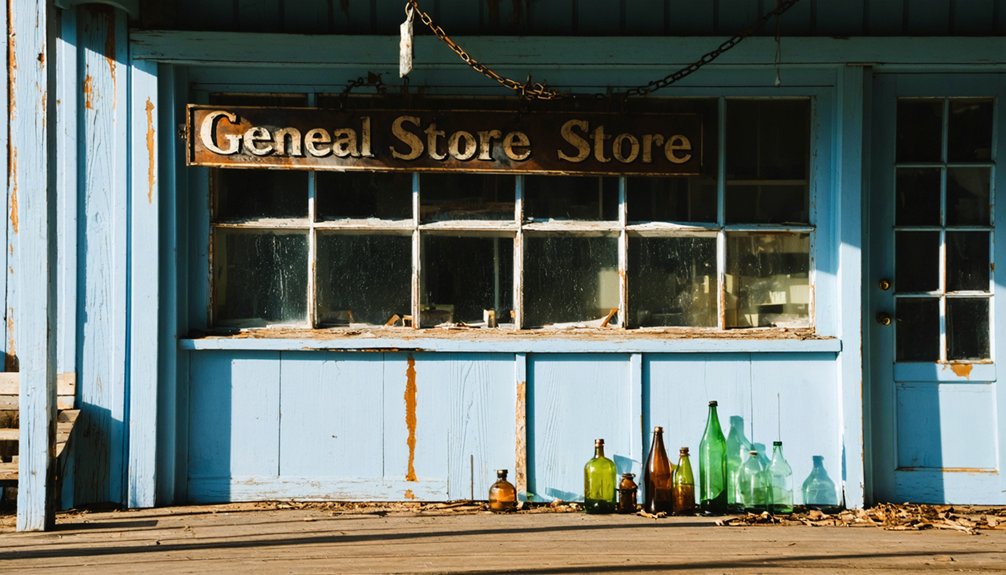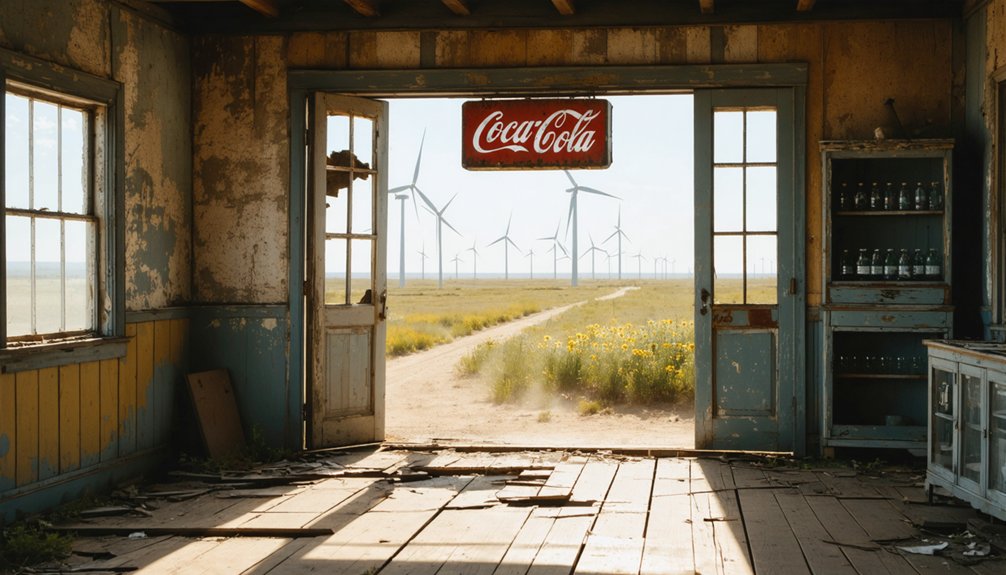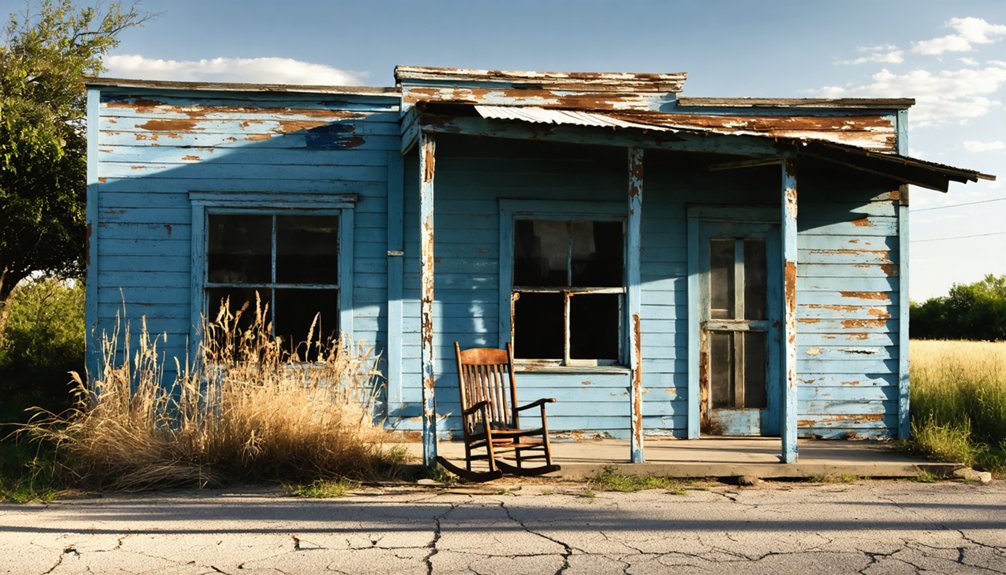You’ll find Parris, Texas nestled along the Trinity River, where Mexican-American War veteran Thaddeus Parris established an ox-powered gristmill in 1859. The mill transformed this settlement into a thriving agricultural hub, attracting farmers and settlers throughout central Collin County. While the town later declined due to shifting agricultural markets and missed railway connections, its legacy lives on through preserved historical records. The story of this ghost town reveals fascinating details about early Texas settlement patterns.
Key Takeaways
- Parris, Texas originated in 1859 as a mill town centered around Thaddeus Parris’s ox-powered gristmill in central Collin County.
- The town flourished as an agricultural hub where farmers gathered for grain processing and social interactions around the gristmill.
- Economic decline began with falling cotton prices, obsolete mill technology, and railroad companies choosing alternate routes for their tracks.
- The community transformed into a ghost town due to technological shifts and competition from industrial-scale production in urban centers.
- Primary historical documentation of Parris is maintained through county historical societies, preserving early settler narratives and community development records.
The Rise of a Mill Town (1859)
Although historical records indicate Paris, Texas was initially settled in 1826, there’s limited evidence supporting its characterization as a mill town in 1859. The settlement patterns of early Paris were primarily shaped by its role as a county seat and its strategic location rather than milling operations.
You’ll find that Paris’s transformation into a thriving community was actually driven by different factors. When the Texas and Pacific Railway arrived in 1873, it sparked significant development and changed the town’s economic trajectory. Local merchant George W. Wright officially established the city in 1844, setting the foundation for its future growth.
The community’s resilience became evident as they adapted to various industries, including cotton farming, manufacturing, and food processing. While other Texas towns may have started as mill towns, Paris’s growth story centered more on its agricultural prowess and its position as a regional trade hub. The city demonstrated remarkable strength when the downtown area was rebuilt within just one year after the devastating Great Fire of 1916.
Thaddeus Parris: Veteran and Pioneer
Within the broader story of early Texas settlements, Thaddeus Parris stands out as both a military veteran and pioneering entrepreneur. Born in Illinois in 1829, his military influence began during the Mexican-American War, where he survived a battle wound near the Rio Grande thanks to a fellow soldier named Feland.
After marrying Hannah Gould in 1848, Parris’s pioneer spirit led him to Texas in 1851. You’ll find his impact most prominently in Grayson and Collin counties, where he first settled in Jamison before establishing roots in Farmington. While in Titus County, he sketched plans on his kitchen floor for what would become an innovative grist mill complex including a store, gin, blacksmith shop, school, and church. Historical records suggest his surname often required name clarification to avoid confusion with the French capital.
His most significant contribution came in 1859 when he founded an ox-powered gristmill that became the heart of what you’d know as Parris, Texas. His entrepreneurial vision transformed the landscape, creating a crucial hub for local farmers and settlers until his death sometime before 1879.
Life Along the Trinity River
As the Trinity River carved its path through southeastern Texas, it shaped both the landscape and lives of Parris’s early settlers.
You’d find them living in harmony with the river’s natural rhythms, adapting to its seasonal floods and harvesting from its fertile bottomlands. The river ecology thrived with water-tolerant hardwoods, oaks, and sycamores stabilizing the banks, while supporting diverse wildlife in the rolling terrain. With elevations spanning 150 to 400 feet, the varied topography created unique microclimates along the riverbank.
Living near the Trinity meant you could enjoy recreational activities like fishing and boating, particularly after the Livingston Reservoir’s creation. Early residents witnessed packet boats transporting goods along the waterway, with river traffic reaching its peak in the 1860s.
The humid subtropical climate, delivering 46 inches of annual rainfall, sustained a 260-day growing season that early farmers relied upon.
You’d witness the river’s influence everywhere – from the sandy-loam soils perfect for agriculture to the hardwood forests that provided timber for the region’s growth.
Agricultural Legacy and Community Growth
You’ll find that Parris’s agricultural story began in 1859 with the establishment of an ox-turned gristmill, which quickly became the heart of this farming community in Collin County.
The mill’s operations attracted settlers to the area and provided essential grain-processing services for local farmers throughout the latter half of the 19th century.
Under the influence of Thaddeus Parris, a Mexican-American War veteran for whom the settlement was named, the community flourished as a central gathering point for area farmers, fostering both economic and social connections in this corner of Texas. Like many other East Texas communities, the introduction of rail lines significantly influenced the town’s development and eventual decline.
Much like how the nearby town of Paris experienced tragedy with its devastating fire in 1916, Parris also faced challenges that shaped its development.
Mill Operations and Growth
The agricultural evolution of Paris, Texas began with early settlers adopting indigenous milling techniques, using wooden pestles and mortars to process their grain.
You’ll find that mill technology advanced rapidly, with horse and mule-powered operations emerging by 1826, featuring horizontal beams strung between trees to drive millstones.
The region’s most innovative early design appeared in Grayson County, where a 125-foot cogged wheel, powered by oxen walking uphill, turned the machinery.
As cotton became king in the 1880s, Paris’s community impact grew through its significant cotton compress operations.
The city’s strategic location on the Texas and Pacific Railway strengthened its position as a milling center, while the compress facility, operating until 1978, symbolized Paris’s essential role in regional cotton markets.
The facility’s two steam presses operated around the clock during peak seasons, demonstrating the robust cotton processing capabilities of the region.
By the end of the nineteenth century, the transition to modern roller mills marked a significant advancement in local grain processing capabilities.
Rural Settlement Patterns
While the Caddo Indians originally inhabited the Red River valley, Paris’s rural settlement patterns emerged from Tennessee and Kentucky migrants who established an unconventional plantation system amid the region’s mainly small family farms.
The cultural influences from these early settlers shaped the area’s settlement dynamics, as they chose a strategic location on a ridge between the Red and Sulphur rivers.
You’ll find that this positioning offered natural protection from floods and excellent drainage.
Farming Community Development
Following Thaddeus Parris’s construction of an ox-turned gristmill in 1859, a vibrant farming community emerged around this vital agricultural hub.
You’ll find that local farmers quickly established diverse operations, combining cotton cash crops with wheat and corn cultivation, while maintaining livestock herds of cattle and goats.
The farming traditions that developed reflected the community’s resilience, as families worked together in all aspects of agricultural production.
You’d see evidence of their interconnected lives through regular gatherings at the gristmill, where farmers processed their grains and strengthened social bonds.
The East Fork of the Trinity River provided essential water resources, supporting the settlement’s agricultural foundation.
While the community eventually declined by the early 20th century, its agricultural legacy influenced regional development patterns throughout central Collin County.
The Gristmill’s Influence on Settlement
You’ll find Thaddeus Parris’s 1859 ox-powered gristmill served as the primary anchor point for early settlement near the East Fork of the Trinity River in Collin County, Texas.
The mill’s grain processing capabilities sparked economic growth by enabling local farmers to process their harvests efficiently, drawing more agricultural families to settle in the area.
As the hub of local commerce and social interaction, the gristmill fostered a thriving community where settlers gathered to trade goods and share news while waiting for their grain to be processed.
Early Settlement Anchor Point
When Thaddeus Parris established his ox-turned gristmill in 1859, he unknowingly created the anchor point that would define a new Texas settlement. His pioneering techniques for grain processing drew settlers to build homes and farms near the East Fork of the Trinity River, just south of present-day Melissa.
You’ll find that the mill’s presence shaped more than just local agriculture – it became the beating heart of community identity, with the town proudly bearing Parris’s name.
As farmers needed the mill’s services, they established roots nearby, transforming the rural landscape into a social and economic hub. Estate records from the 1870s show how deeply intertwined families became with this frontier mill town, where daily life centered around the steady rhythm of ox-powered grain processing.
Economic Growth Through Milling
The ox-turned gristmill transformed Parris into a thriving economic center through three key developments: expanded grain processing capabilities, reduced transportation costs for local farmers, and the emergence of complementary businesses.
You’ll find that the milling techniques employed at Parris’s gristmill, while slower than water-powered alternatives, proved essential to the region’s economic strategies.
Local farmers no longer needed to transport their wheat and corn to distant processing facilities, which greatly cut their expenses and crop losses.
The mill’s presence sparked the growth of supporting enterprises like blacksmith shops and general stores, creating a vibrant commercial hub.
As farmers gathered to process their grain, they’d exchange critical information and establish trade networks, strengthening the community’s economic foundation and self-sufficiency throughout the late 1800s.
Community Gathering and Trade
Standing as both a cornerstone of commerce and community life, Thaddeus Parris’s ox-turned gristmill shaped the social fabric of early Parris settlement from its establishment in 1859.
You’d find settlers converging at the mill near the East Fork of the Trinity River not just for grain processing, but to forge essential social networks through regular gatherings and trade.
The mill site transformed into a bustling hub where community events naturally emerged during milling days, with farmers exchanging news, bartering goods, and coordinating collective work efforts.
The strategic location attracted additional businesses like blacksmiths and general stores, while influencing where pioneers chose to build their homes.
This concentration of activity established Parris as a recognized community center in central Collin County.
Daily Life in 19th Century Parris
Life in nineteenth-century Parris centered around its ox-turned gristmill, where local farmers gathered regularly to process their grain harvests.
You’d find strong community bonds forming as families worked together, sharing labor during peak farming seasons at an elevation of 551 feet near the East Fork of the Trinity River.
Your daily routines would’ve revolved around agricultural tasks, with oxen powering both the mill and field operations.
From sunrise to sunset, farmers and their oxen worked in unison, powering the vital machinery of rural life.
In this close-knit farming settlement, you’d spend your days tending to crops, maintaining livestock, and exchanging support with neighbors.
The community center served as your social hub, where you’d gather for events tied to farming cycles.
Without modern amenities, you’d rely on the river for irrigation and the gristmill for processing your harvests.
Economic Factors Behind the Decline

You’ll find that Parris’s decline closely tracked the major shifts in agricultural markets during the late 19th century, when cotton prices plummeted and local farmers struggled to maintain profitability.
The town’s mills, which hadn’t kept pace with technological advancements in grain processing, became increasingly obsolete and eventually shut down.
The final blow came when the railroad companies chose alternate routes through Texas, effectively cutting off Parris from essential transportation networks and new market opportunities.
Agricultural Market Changes
As Texas agriculture underwent dramatic changes between 1910 and 1960, Parris’s economic foundation crumbled alongside its once-thriving farming industry.
You’ll find stark evidence of these agricultural shifts in the area’s cotton production, which plummeted from 69,264 bales in 1920 to just 16,233 bales by 1959.
The local workforce‘s market adaptations tell an equally dramatic story – while only 600 people worked in business in 1900, that number soared to over 5,000 by 1960.
The final blow to Parris’s agricultural heritage came in 1978 when the Paris Cotton Compress shut down.
Mill Technology Evolution
The technological evolution of Parris’s mills marked a pivotal shift in the town’s economic decline, beginning with the dominance of water-powered operations in the 19th century.
You’d have seen the town’s early mills along creeks and rivers, where water wheels powered grain grinding and timber sawing operations.
But when steam power arrived in the late 1800s, Parris’s mill technology couldn’t keep pace with the changing times.
While larger cities invested in steam-powered facilities that could operate year-round, Parris’s water-dependent mills struggled with seasonal fluctuations and maintenance costs.
The shift to automation and industrial-scale production in urban centers dealt the final blow, as you couldn’t find enough local craftsmen or capital to modernize the town’s aging mills.
This technological gap eventually forced many operations to close.
Railroad Access Impact
Railroad development initially promised prosperity for Parris during the late 19th century, with multiple major rail lines converging on the town between 1876 and 1909.
You could’ve witnessed the town’s golden age as the Gulf, Colorado and Santa Fe Railway, Texas & Pacific, and other major lines transformed Parris into an essential transportation hub. The railroads enabled local cotton, timber, and agricultural products to reach national markets efficiently.
But railroad decline hit Parris hard when the Chaparral Railroad’s freight abandonment in 1995 severed critical economic arteries.
You won’t find trains running through town anymore – just a rail-trail where freight once moved. The loss of rail service contributed notably to Parris’s transformation into a ghost town, as industries dependent on rail transport withered and the local economy couldn’t adapt.
Preserved Through Historical Records

Historical records provide a detailed window into Parris’ past through extensive documentation preserved in Collin County archives and state repositories.
Through archival research, you’ll discover probate minutes from 1871-1879 that detail Thaddeus Parris’ estate, offering insights into the town’s early settlers and property ownership. These records trace back to 1859 when the Mexican-American War veteran established his ox-turned gristmill.
The town’s historical preservation efforts guarantee you can access primary sources including maps, land claims, and settlement narratives at county historical societies.
You’ll find documentation of Parris’ position within Collin County’s agricultural development, along with geographic records showing its location near Melissa and the East Fork of Trinity River.
Digital preservation now makes these materials readily available for your research into this vanished community.
Geographic Features and Natural Setting
Physical remnants of Parris now rest amid the gently rolling plains of Collin County, where you’ll find the ghost town’s site at 551 feet above sea level near the East Fork of Trinity River.
The town’s location within the Blackland Prairie ecoregion provided rich soil and natural resources that early settlers enthusiastically utilized for farming and milling operations.
The fertile Blackland Prairie sustained generations of settlers who transformed its rich soils into prosperous farms and bustling mills.
The riverine economy once thrived here, taking advantage of the waterway’s potential for powering mills.
Today, you’ll encounter a landscape of native tallgrass prairie dotted with scattered trees, experiencing the region’s characteristic hot summers and cool winters.
While the site lacks dramatic geological features, its gentle topography and proximity to the river made it an ideal settlement location until changing transportation patterns left Parris behind.
Modern-Day Significance and Heritage

While Parris once thrived as a bustling settlement, today’s visitors will find a stark contrast in Paris, Texas – a vibrant city that rose from the same region but evolved into a cultural hub with its own unique identity.
The city’s spirit shines through its commitment to architectural preservation and dynamic cultural festivals, creating a destination that honors both its past and future.
You’ll discover four key elements that define Paris’s modern heritage:
- A 65-foot Eiffel Tower replica crowned with a cowboy hat
- Historic downtown buildings restored after the 1916 fire
- Annual events like the Tour de Paris and ASA Archery Tournaments
- The Sam Bell Maxey House, showcasing the region’s cultural legacy
This blend of preservation and progress has transformed Paris into a regional center for manufacturing, healthcare, and education while maintaining its distinctive Texas charm.
Frequently Asked Questions
Are There Any Visible Ruins or Structures Still Standing at Parris Today?
You won’t find any visible structures in this ghost town today – time has reclaimed the area completely, leaving no standing buildings or ruins for you to explore or photograph.
What Happened to the Descendants of Thaddeus Parris After the Town’s Decline?
You’ll find descendant stories spread across Texas, with many settling in Paris and Northeast Texas cities. Family legacies continued through urban jobs, while others preserved their heritage through reunions and archives.
Did Any Notable Outlaws or Gunfights Occur in Parris?
You won’t find any documented outlaws or gunfights in Parris’ history, despite wild tales from nearby areas. The town’s struggles centered on political battles rather than any shoot-’em-up frontier violence.
Were There Any Native American Settlements Near Parris Before Its Founding?
You’ll find the Kadohadacho Indians, part of the Caddo nation, established Native settlements near the Red River valley. Their cultural influence on the region lasted until European settlers arrived.
What Was the Peak Population of Parris During Its Most Prosperous Years?
You’ll find the peak population reached 150 residents during the town’s most prosperous years, when the local economy centered on cattle and farming activities, marking its highest point of population growth.
References
- https://en.wikipedia.org/wiki/Parris
- https://www.youtube.com/watch?v=q6q0CFbDdCQ
- https://www.tpr.org/texas/2017-10-30/boo-the-rise-and-fall-of-texas-ghost-towns
- https://www.britannica.com/place/Paris-Texas
- https://milliverstravels.com/2012/08/paris-texas-the-city-of-ghost-sightings/
- https://mix931fm.com/texas-ghost-towns-history/
- https://www.texasescapes.com/TexasGhostTowns/Taylor-Town-Texas.htm
- https://myparistexas.com/netx-paranormal-society/
- https://visitparistexas.com/downtown-history/
- https://selectparistexas.com/live-in-paris/our-history/



